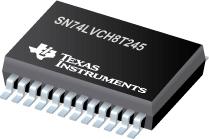●The SN74LVCH8T245 is an 8-bit noninverting bus transceiver that uses two separate configurable power-supply rails. The A port is designed to track VCCA, which accepts any supply voltage from 1.65 V to 5.5 V. The B port is designed to track VCCB, which also accepts any supply voltage from 1.65 V to 5.5 V. This allows for universal low-voltage bidirectional translation between any of the 1.8-V, 2.5-V, 3.3-V, and 5.5-V voltage nodes.
●The SN74LVCH8T245 is designed for asynchronous communication between two data buses. The logic levels of the direction-control (DIR) input and the output-enable (OE) input activate either the B-port outputs, the A-port outputs, or place both output ports into a high-impedance state. The device transmits data from the A bus to the B bus when the B-port outputs are activated, and from the B bus to the A bus when the A-port outputs are activated. The input circuitry on both A and B ports are always active.
●The SN74LVCH8T245 is designed so that the control pins (DIR and OE) are referenced to VCCA.
●Active bus-hold circuitry holds unused or undriven inputs at a valid logic state. Use of pullup or pulldown resistors with the bus-hold circuitry is not recommended.
●This device is fully specified for partial-power-down applications using Ioff. The Ioff circuitry disables the outputs, preventing damaging current backflow through the device.
●The VCC isolation feature ensures that if either VCCA or VCCB is at GND, then the outputs are in the high-impedance state.
●To ensure the high-impedance state during power up or power down, OE should be tied to VCCA through a pullup resistor; the minimum value of the resistor is determined by the current-sinking capability of the driver.
● Control Inputs (DIR and OE) VIH and VIL Levels
●are Referenced to VCCA
● Bus Hold on Data Inputs Eliminates the Need for
●External Pullup and Pulldown Resistors
● VCC Isolation
● Fully Configurable Dual-Rail Design
● Ioff Supports Partial-Power-Down Mode Operation
● Latch-Up Performance Exceeds 100 mA Per
●JESD 78, Class II
● ESD Protection Exceeds JESD 22



